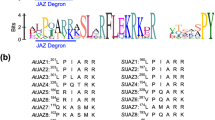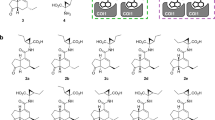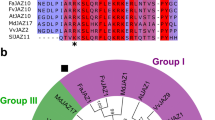Abstract
(+)-7-iso-Jasmonoyl-L-isoleucine (JA-Ile) regulates developmental and stress responses in plants. Its perception involves the formation of a ternary complex with the F-box COI1 and a member of the JAZ family of co-repressors and leads to JAZ degradation. Coronatine (COR) is a bacterial phytotoxin that functionally mimics JA-Ile and interacts with the COI1-JAZ co-receptor with higher affinity than JA-Ile. On the basis of the co-receptor structure, we designed ligand derivatives that spatially impede the interaction of the co-receptor proteins and, therefore, should act as competitive antagonists. One derivative, coronatine-O-methyloxime (COR-MO), has strong activity in preventing the COI1-JAZ interaction, JAZ degradation and the effects of JA-Ile or COR on several JA-mediated responses in Arabidopsis thaliana. Moreover, it potentiates plant resistance, preventing the effect of bacterially produced COR during Pseudomonas syringae infections in different plant species. In addition to the utility of COR-MO for plant biology research, our results underscore its biotechnological potential for safer and sustainable agriculture.
This is a preview of subscription content, access via your institution
Access options
Subscribe to this journal
Receive 12 print issues and online access
$259.00 per year
only $21.58 per issue
Buy this article
- Purchase on Springer Link
- Instant access to full article PDF
Prices may be subject to local taxes which are calculated during checkout




Similar content being viewed by others
References
Browse, J. & Howe, G.A. New weapons and a rapid response against insect attack. Plant Physiol. 146, 832–838 (2008).
Chico, J.M., Chini, A., Fonseca, S. & Solano, R. JAZ repressors set the rhythm in jasmonate signaling. Curr. Opin. Plant Biol. 11, 486–494 (2008).
Farmer, E.E., Almeras, E. & Krishnamurthy, V. Jasmonates and related oxylipins in plant responses to pathogenesis and herbivory. Curr. Opin. Plant Biol. 6, 372–378 (2003).
Fonseca, S. et al. (+)-7-iso-Jasmonoyl-L-isoleucine is the endogenous bioactive jasmonate. Nat. Chem. Biol. 5, 344–350 (2009).
Wasternack, C. Jasmonates: an update on biosynthesis, signal transduction and action in plant stress response, growth and development. Ann. Bot. (Lond.) 100, 681–697 (2007).
Wasternack, C. & Hause, B. Jasmonates: biosynthesis, perception, signal transduction and action in plant stress response, growth and development. An update to the 2007 review in Annals of Botany. Ann. Bot. (Lond.) 111, 1021–1058 (2013).
Fonseca, S. et al. bHLH003, bHLH013 and bHLH017 are new targets of JAZ repressors negatively regulating JA responses. PLoS ONE 9, e86182 (2014).
Nakata, M. et al. A bHLH-type transcription factor, ABA-INDUCIBLE BHLH-TYPE TRANSCRIPTION FACTOR/JA-ASSOCIATED MYC2-LIKE1, acts as a repressor to negatively regulate jasmonate signaling in Arabidopsis. Plant Cell 25, 1641–1656 (2013).
Pauwels, L. & Goossens, A. The JAZ proteins: a crucial interface in the jasmonate signaling cascade. Plant Cell 23, 3089–3100 (2011).
Sasaki-Sekimoto, Y. et al. Basic helix-loop-helix transcription factors JASMONATE-ASSOCIATED MYC2-LIKE1 (JAM1), JAM2, and JAM3 are negative regulators of jasmonate responses in Arabidopsis. Plant Physiol. 163, 291–304 (2013).
Song, S. et al. The bHLH subgroup IIId factors negatively regulate jasmonate-mediated plant defense and development. PLoS Genet. 9, e1003653 (2013).
Chini, A. et al. The JAZ family of repressors is the missing link in jasmonate signalling. Nature 448, 666–671 (2007).
Thines, B. et al. JAZ repressor proteins are targets of the SCFCOI1 complex during jasmonate signalling. Nature 448, 661–665 (2007).
Yan, Y. et al. A downstream mediator in the growth repression limb of the jasmonate pathway. Plant Cell 19, 2470–2483 (2007).
Pauwels, L. et al. NINJA connects the co-repressor TOPLESS to jasmonate signalling. Nature 464, 788–791 (2010).
Browse, J. The power of mutants for investigating jasmonate biosynthesis and signaling. Phytochemistry 70, 1539–1546 (2009).
Staswick, P.E., Yuen, G.Y. & Lehman, C.C. Jasmonate signaling mutants of Arabidopsis are susceptible to the soil fungus Pythium irregulare. Plant J. 15, 747–754 (1998).
Vijayan, P., Shockey, J., Levesque, C.A., Cook, R.J. & Browse, J. A role for jasmonate in pathogen defense of Arabidopsis. Proc. Natl. Acad. Sci. USA 95, 7209–7214 (1998).
Xie, D.X., Feys, B.F., James, S., Nieto-Rostro, M. & Turner, J.G. COI1: an Arabidopsis gene required for jasmonate-regulated defense and fertility. Science 280, 1091–1094 (1998).
Yan, J. et al. The Arabidopsis CORONATINE INSENSITIVE1 protein is a jasmonate receptor. Plant Cell 21, 2220–2236 (2009).
Katsir, L., Schilmiller, A.L., Staswick, P.E., He, S.Y. & Howe, G.A. COI1 is a critical component of a receptor for jasmonate and the bacterial virulence factor coronatine. Proc. Natl. Acad. Sci. USA 105, 7100–7105 (2008).
Sheard, L.B. et al. Jasmonate perception by inositol-phosphate–potentiated COI1-JAZ co-receptor. Nature 468, 400–405 (2010).
Tan, X. et al. Mechanism of auxin perception by the TIR1 ubiquitin ligase. Nature 446, 640–645 (2007).
Saracco, S.A. et al. Tandem affinity purification and mass spectrometric analysis of ubiquitylated proteins in Arabidopsis. Plant J. 59, 344–358 (2009).
Maor, R. et al. Multidimensional protein identification technology (MudPIT) analysis of ubiquitinated proteins in plants. Mol. Cell. Proteomics 6, 601–610 (2007).
Cheng, Z. et al. The bHLH transcription factor MYC3 interacts with the Jasmonate ZIM-domain proteins to mediate jasmonate response in Arabidopsis. Mol. Plant 4, 279–288 (2011).
Fernández-Calvo, P. et al. The Arabidopsis bHLH transcription factors MYC3 and MYC4 are targets of JAZ repressors and act additively with MYC2 in the activation of jasmonate responses. Plant Cell 23, 701–715 (2011).
Hu, Y., Jiang, L., Wang, F. & Yu, D. Jasmonate regulates the INDUCER OF CBF EXPRESSION-C-REPEAT BINDING FACTOR/DRE BINDING FACTOR1 cascade and freezing tolerance in Arabidopsis. Plant Cell 25, 2907–2924 (2013).
Lorenzo, O., Chico, J.M., Sanchez-Serrano, J.J. & Solano, R. JASMONATE-INSENSITIVE1 encodes a MYC transcription factor essential to discriminate between different jasmonate-regulated defense responses in Arabidopsis. Plant Cell 16, 1938–1950 (2004).
Niu, Y., Figueroa, P. & Browse, J. Characterization of JAZ-interacting bHLH transcription factors that regulate jasmonate responses in Arabidopsis. J. Exp. Bot. 62, 2143–2154 (2011).
Qi, T. et al. The Jasmonate-ZIM-domain proteins interact with the WD-Repeat/bHLH/MYB complexes to regulate Jasmonate-mediated anthocyanin accumulation and trichome initiation in Arabidopsis thaliana. Plant Cell 23, 1795–1814 (2011).
Song, S. et al. The Jasmonate-ZIM domain proteins interact with the R2R3-MYB transcription factors MYB21 and MYB24 to affect Jasmonate-regulated stamen development in Arabidopsis. Plant Cell 23, 1000–1013 (2011).
Bender, C.L., Alarcon-Chaidez, F. & Gross, D.C. Pseudomonas syringae phytotoxins: mode of action, regulation, and biosynthesis by peptide and polyketide synthetases. Microbiol. Mol. Biol. Rev. 63, 266–292 (1999).
Uppalapati, S.R. et al. The phytotoxin coronatine contributes to pathogen fitness and is required for suppression of salicylic acid accumulation in tomato inoculated with Pseudomonas syringae pv. tomato DC3000. Mol. Plant Microbe Interact. 20, 955–965 (2007).
Zhao, Y. et al. Virulence systems of Pseudomonas syringae pv. tomato promote bacterial speck disease in tomato by targeting the jasmonate signaling pathway. Plant J. 36, 485–499 (2003).
Brooks, D.M. et al. Identification and characterization of a well-defined series of coronatine biosynthetic mutants of Pseudomonas syringae pv. tomato DC3000. Mol. Plant Microbe Interact. 17, 162–174 (2004).
Melotto, M., Underwood, W., Koczan, J., Nomura, K. & He, S.Y. Plant stomata function in innate immunity against bacterial invasion. Cell 126, 969–980 (2006).
Fonseca, S., Chico, J.M. & Solano, R. The jasmonate pathway: the ligand, the receptor and the core signalling module. Curr. Opin. Plant Biol. 12, 539–547 (2009).
Hayashi, K. et al. Rational design of an auxin antagonist of the SCFTIR1 auxin receptor complex. ACS Chem. Biol. 7, 590–598 (2012).
Staswick, P.E. The tryptophan conjugates of jasmonic and indole-3-acetic acids are endogenous auxin inhibitors. Plant Physiol. 150, 1310–1321 (2009).
Katsir, L., Chung, H.S., Koo, A.J. & Howe, G.A. Jasmonate signaling: a conserved mechanism of hormone sensing. Curr. Opin. Plant Biol. 11, 428–435 (2008).
Chini, A., Boter, M. & Solano, R. Plant oxylipins: COI1/JAZs/MYC2 as the core jasmonic acid–signalling module. FEBS J. 276, 4682–4692 (2009).
Gimenez-Ibanez, S. & Solano, R. Nuclear jasmonate and salicylate signaling and crosstalk in defense against pathogens. Front Plant Sci 4, 72 (2013).
Robert-Seilaniantz, A., Grant, M. & Jones, J.D. Hormone crosstalk in plant disease and defense: more than just jasmonate-salicylate antagonism. Annu. Rev. Phytopathol. 49, 317–343 (2011).
Lamberth, C., Jeanmart, S., Luksch, T. & Plant, A. Current challenges and trends in the discovery of agrochemicals. Science 341, 742–746 (2013).
Marcos, J.F., Munoz, A., Perez-Paya, E., Misra, S. & Lopez-Garcia, B. Identification and rational design of novel antimicrobial peptides for plant protection. Annu. Rev. Phytopathol. 46, 273–301 (2008).
Enserink, M., Hines, P.J., Vignieri, S.N., Wigginton, N.S. & Yeston, J.S. Smarter pest control. The pesticide paradox. Introduction. Science 341, 728–729 (2013).
Xin, X.F. & He, S.Y. Pseudomonas syringae pv. tomato DC3000: a model pathogen for probing disease susceptibility and hormone signaling in plants. Annu. Rev. Phytopathol. 51, 473–498 (2013).
Gimenez-Ibanez, S. et al. The bacterial effector HopX1 targets JAZ transcriptional repressors to activate jasmonate signaling and promote infection in Arabidopsis. PLoS Biol. 12, e1001792 (2014).
Boyd, L.A., Ridout, C., O'Sullivan, D.M., Leach, J.E. & Leung, H. Plant-pathogen interactions: disease resistance in modern agriculture. Trends Genet. 29, 233–240 (2013).
Adie, B.A. et al. ABA is an essential signal for plant resistance to pathogens affecting JA biosynthesis and the activation of defenses in Arabidopsis. Plant Cell 19, 1665–1681 (2007).
Hayashi, K. et al. Small-molecule agonists and antagonists of F-box protein-substrate interactions in auxin perception and signaling. Proc. Natl. Acad. Sci. USA 105, 5632–5637 (2008).
Okada, M. et al. Total syntheses of coronatines by exo-selective Diels-Alder reaction and their biological activities on stomatal opening. Org. Biomol. Chem. 7, 3065–3073 (2009).
Nonaka, H., Ogawa, N., Maeda, N., Wang, Y.-G. & Kobayashi, Y. Stereoselective synthesis of epi-jasmonic acid, tuberonic acid, and 12-oxo-PDA. Org. Biomol. Chem. 8, 5212–5223 (2010).
Fonseca, S. & Solano, R. Pull-down analysis of interactions among jasmonic acid core signaling proteins. Methods Mol. Biol. 1011, 159–171 (2013).
Chini, A., Fonseca, S., Chico, J.M., Fernandez-Calvo, P. & Solano, R. The ZIM domain mediates homo- and heteromeric interactions between Arabidopsis JAZ proteins. Plant J. 59, 77–87 (2009).
Benjamini, Y. & Hochberg, Y. Controlling the false discovery rate: a practical and powerful approach to multiple testing. J. R. Stat. Soc. Series B Stat Methodol. 57, 289–300 (1995).
Acknowledgements
We thank K.-i. Hayashi (Okayama University) for important suggestions for the design of the antagonists. J. Browse (Washington State University) kindly provided the 35S:JAZ1-GUS seeds. M. Estelle (University of California–San Diego) kindly provided DR5:GUS and Dexp:TIR1-myc/tir1-1 seeds and the IAA7-GST clone. We obtained the fungal pathogen B. cinerea from E. Monte (Instituto Hispano-Luso de Investigaciones Agrarias (CIALE)). We also thank J. Paz-Ares (CNB-CSIC) and members of the lab for critical reading of the manuscript and suggestions. This work was financed by grants to R.S. (BIO2010-21739, CSD2007-00057 and EUI2008-03666) from the Spanish Ministerio de Ciencia e Innovación. I.M. was supported by a predoctoral fellowship from the Ministerio de Educación, Spain (grant AP2010-1410). A.C. and S.G.-I. were supported by postdoctoral fellowships from the Spanish Ministerio de Ciencia e Innovación ('Ramón y Cajal' 2010-05680 and 'Juan de la Cierva' JCI-2010-07532, respectively). M.B. was supported by a JAE-Doc fellowship (2010-01411) from CSIC.
Author information
Authors and Affiliations
Contributions
I.M., A.C. and R.S. designed the research. I.M., A.C., S.G.-I., G.G.-C. and M.B. performed experiments and wrote the corresponding methods. M.H. synthesized the derivatives and wrote the corresponding methods. A.P. obtained the NMR data. F.P. performed in silico analyses. I.M. and R.S. wrote the manuscript. All of the authors read and edited the manuscript.
Corresponding author
Ethics declarations
Competing interests
The authors declare no competing financial interests.
Supplementary information
Supplementary Text and Figures
Supplementary Results, Supplementary Figures 1–8 and Supplementary Tables 1–4. (PDF 5504 kb)
Supplementary Table 1
Genes upregulated and downregulated by COR-MO in the profiling of plants treated with COR versus COR-COR-MO (XLSX 41 kb)
Rights and permissions
About this article
Cite this article
Monte, I., Hamberg, M., Chini, A. et al. Rational design of a ligand-based antagonist of jasmonate perception. Nat Chem Biol 10, 671–676 (2014). https://doi.org/10.1038/nchembio.1575
Received:
Accepted:
Published:
Issue Date:
DOI: https://doi.org/10.1038/nchembio.1575
This article is cited by
-
Subtype-selective agonists of plant hormone co-receptor COI1-JAZs identified from the stereoisomers of coronatine
Communications Biology (2023)
-
Exploring the interaction mechanism between antagonist and the jasmonate receptor complex by molecular dynamics simulation
Journal of Computer-Aided Molecular Design (2022)
-
Role of jasmonic acid in plants: the molecular point of view
Plant Cell Reports (2021)
-
The stereoisomeric Bacillus subtilis HN09 metabolite 3,4-dihydroxy-3-methyl-2-pentanone induces disease resistance in Arabidopsis via different signalling pathways
BMC Plant Biology (2019)
-
Jasmonate-mediated wound signalling promotes plant regeneration
Nature Plants (2019)



